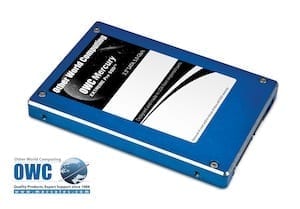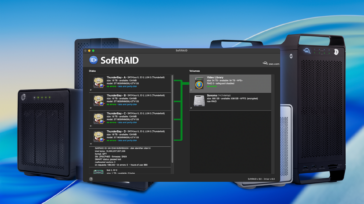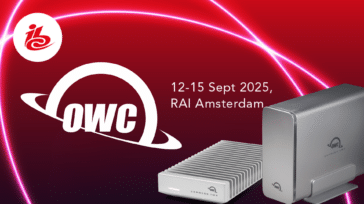 Other World Computing announced today a new 40GB model to its award-winning OWC Mercury Extreme Pro SSD™ line as the most affordable high performance SandForce® Processor based Solid State Drive on the market. Designed and made in the U.S. from imported parts, the new OWC Mercury Extreme Pro 40GB SSD’s special introductory pricing of $99.99 makes it the lowest priced SSD on the market to offer three key high performance features:
Other World Computing announced today a new 40GB model to its award-winning OWC Mercury Extreme Pro SSD™ line as the most affordable high performance SandForce® Processor based Solid State Drive on the market. Designed and made in the U.S. from imported parts, the new OWC Mercury Extreme Pro 40GB SSD’s special introductory pricing of $99.99 makes it the lowest priced SSD on the market to offer three key high performance features:
- Industry leading sustained Read AND Write speeds over 260MB/s (with peak speeds up to 285MB/s).
- Best in class error correction (ECC) and SandForce RAISE™ redundancy with 7% over provisioning.
- SandForce DuraClass™ technology with ultra-efficient Block Management & Wear Leveling for long term durability.
The OWC Mercury Extreme Pro SSD line, which has won Editor’s choice awards and review comments like “Eye popping speed with consistent performance over time”, “Best write speeds we’ve seen”, and “The fastest SSD to hit our test bench yet” from leading performance testing sites like Tweaktown, Hot Hardware, MacPerformanceGuide, Maximum PC, Storage Review and Benchmark Reviews, is available for immediate ordering in nine configurations from 40GB to 480GB starting at $99.99. All models are Macintosh® and PC compatible and install easily into notebooks, as well as into desktops/towers with an OWC Multi-Mount adapter kit sold separately.
For more information on the OWC Mercury Extreme Pro SSD line, including Reseller inquiries, visit: https://eshop.macsales.com/shop/internal_storage/Mercury_Extreme_SSD_Sandforce.
For more information on the OWC Multi-Mount drive adapter kit useful for securely installing smaller form factor (2.5“ & 3.5″) hard drives and SSDs into larger sized (3.5″ & 5.25″) drive bays in Apple Mac Pro, Apple PowerMac, PC desktop, and PC tower computers, visit: https://eshop.macsales.com/owcpages/multimount/multimount.html
Doesn’t Slow Down With Use Like Ordinary SSDs
Ordinary SSDs offer fast read/write performance during first initial uses, but then experience significant write speed degradation over repeated usage. Independent simulation tests by leading drive performance experts (http://macperformanceguide.com/SSD-RealWorld.html) confirm the OWC Mercury Extreme Pro SSD’s ultra-efficient Block Management & Wear Leveling technologies are able to eliminate virtually any reduction in data transfer speeds over heavy long term usage of the drive and without dependency on less than effective OS TRIM management.
Longer Notebook Battery Runtime
Because the OWC Mercury Extreme Pro SSD uses as little as 1/3 the power compared to the most power efficient 2.5“ hard drives and up to 1/2 less power than other leading brand SSDs without any performance sacrifice, notebook users can now maximize their “unplugged” mobile use time while desktop/tower users can enjoy the benefits of a more energy efficient system.
Video Highlights Performance Gains
The OWC Mercury Extreme Pro SSD models are an ideal way for typical Mac or PC desktop and/or notebook computer users to dramatically increase the performance of their existing machine. In several side-by-side comparison tests (https://eshop.macsales.com/Video/SSD/Performance_Test) the OWC Mercury Extreme Pro SSD was able to boot the OS and load six apps up to four times faster than the factory stock configuration. And even older machines equipped with an OWC Mercury Extreme Pro SSD saw an up to 2.5 times faster performance gain over newer machines with faster processors and more RAM.
“Throughout this revolutionary product’s evolution, it has scored numerous industry achievements,” said Larry O’Connor, Founder and CEO, Other World Computing. “From being initially announced as the fastest SSD on the market, to offering the highest capacity found in a SandForce-based SSD, to now offering the most affordable high performance model available on the market, the OWC Mercury Extreme Pro SSD line continues to make headlines for all the right reasons.”








Hi!
Just bought a 40GB Mercury Extreme pro (my first SSD) and I`m glad to find it benchmarked here in the comments section. It`s wonderful OWC staff did respond to Mike`s concern in such a timely manner. OWC: You are a great company and your comments show how much you care about your clients!
Thank you for taking the time to reply to my concerns. I think your points were right on the mark.
After my post, I did some reading and agree with everything you mention. I guess I really over reacted. I went and downloaded Atto, and get a peak of 245MB read and 238MB write where you have your peaks up there. Half on the first 5 lower ones. I’m sure on the right day, with the wind blowing in just the right direction, it will test out with better numbers like yours (I recognize the invariable of repeated and superfluous benchmarks and just using it as a performance watermark so to speak). But I broke 200MB on the read and write and then some, so I’m happy.
You are correct that I’m throwing out prices at the best price in Canada as of two nights ago and factoring in MIR. I don’t have to pay brokerage on Canadian purchases, so if you have Canadian distributors at similar price in Canada, you will be competitive. Today, without rebate you have better price when I tack on $5 brokerage, with rebate they do by ~$10 (MIR postage factored in), so its neck and neck. Competition is good for *me*. :) Having a longer laster drive will prove out the value over time and will make up any difference in a few bucks. Having the better product allows you to SET the price point. I do consider myself to have gotten good return on my investment. This is the computer industry, prices fall all the time, buying earlier for a few bucks more means you’ve had it that much longer to make up for the extra price. I’m an SSD only convert now for any OS drive I’ll ever own (until the next new technology comes along).
I’m looking forward to seeing how this drive fares over time and will be keeping it. Having a three year warranty on a low margin item implies you have high confidence in it or you wouldn’t make profit.
I’ll see how the benchmarks play out over time as the benchmarks for real world evolve for better comparable SSD testing. Reading up some, different controller technologies really need different methods to measure their best numbers. But really, I really care about: boot time, shutdown time, responsiveness, speed, reliability. I can measure 3/5 of those myself by just using it day to day, reliability I can only find out over time, and speed is the missing indicator that gets into this benchmarking guesswork. So thats that.
All in all, its going to be pretty dang fast.
Hi Mike…glad to hear your concerns have been satisfied. On your interest about how the drives will fare over long term…we have the answer for that too…Check out this “seasoning” test from Macperformanceguide:
http://macperformanceguide.com/SSD-RealWorld-Seasoning.html
Bottom line…OWC SSDs start fast and stay fast.
I have identical results as Shay does for the screenshot mentioned at the url he linked to +/- 3. This is not what I expected and very disappointed. I feel like OWC is quoting the specs for the 100GB SSD and not the 40GB. You can see from the Idilinx models where the 32GB was always clearly spec’d much lower than the 64+GB drives. Here, you specifically put out press releases using the 285/275MB numbers for this specific model and using reviews from different models that do not meet same performance.
You also quote 50,000 IOPS, when we know the firmware cannot do that.
Access times are not less than 0.1ms as stated.
You list this as having 40GB of usable capacity. Usable capacity on my Win7 is 37.7GB. That is the number that should be quoted. Or just take out the word “usable” as most people will know to subtract from 40GB.
Spec:
40GB usable capacity
Total Flash Memory Components – 43GB
3GB allocated to real-time data redundancy & error correction
Using AS SSD Benchmark
OWC Sequential spec:
285MB Read
275MB Write
Bench mark: Read = 145MB. Write = 69MB
OCZ Agility 64GB Sequential spec:
235MB Read
135MB Write
Bench mark: Read= 199MB and Write=110.
My expectation for this “upgrade” was to break 200MB on read and maybe break 200MB on write, but at the very least break 150MB. These sequantial writes are similar to Indilinx 32GB (except for 4kb performance).
MB: GIGABYTE GA-770TA-UD3
CPU: Athlon II x4 630
RAM: 8GB DDR3
Agility 64 scores 7.2 in Windows 7 WEI.
If I don’t see improvement in the next week, I’ll be returning this under the 30 day guarantee. At the time of purchase, your closest competitor was OCZ Vertex 2, with similar specs, but higher than the introductory price by about $30. In the last two weeks, the price (for Vertex 2 40GB and Vertex 60GB extended) has dropped and is cheaper than the Mercury at the $115 price. I purchased the Mercury because it was supposed to maintain performance over time and not slowdown, but I’m finding the performance isn’t there to begin with!
Please let us know which benchmark utility we should be using, and if these results will be typical for this model.
p.s. if this gets posted multiple times, you should indicate the post is put up in real time or needs to be approved or something. Right now, it just looks like I didnt post a really long post.
Hi Mike…we’ll try to alleviate your concerns:
The industry standard of “1GB = 1,000,000,000 bytes” is what our advertised unformatted capacity is based on. Depending on the operating system or utility, capacity may be displayed with this industry standard or using math displays a value based on “1GB = 1,073,741,824 bytes” that is the result of a computer’s binary which at the core is 8 bits to a byte, 1024 bytes to a Kilobyte. This industry standard is how hard drives and Solid State Drive manufacturers provide storage capacity, including that used by the other SSD makers you reference. For what it’s worth, Mac OS 10.6.x displays based on the industry ‘base 10’ standard while Mac OS 10.5.x and prior – as well as Windows – displays a calculation using the binary (base 2) calculation. Here are some links to information this as well as other factors of formatted capacity:
http://eshop.macsales.com/Search/displayFAQDetails.cfm?ID=25
and
http://lifehacker.com/5349204/snow-leopard-reports-hard-drive-capacity-correctly-in-base-10
The total flash capacity of the the SSD you purchased from us provides a total of 40GB of useable capacity which is the result from a total capacity of 43GB with 3GB of this reserved/over provisioned. This reserve/over provisioned portion is effective for Sandforce DuraWrite and RAISE technologies which provide, among other things, unparalleled long term durability, reliability, and even real-time data transfer redundancy.
– Regarding the 50,000 IOPS and access time specifications, those are direct from SandForce specifications that other SandForce based SSD manufacturers use as well. And important to note that we say “up to 50,000 IOPS.”
Both of these Sandforce specifications are fully backed, provable, and are reflective of what these drives are truly capable of. The fastest mechanical hard drives support less than 500 (Five Hundred) IOP/s and very few applications, which through computer operating systems have data access schemas to best make use of expected hard drive I/O capabilities, are even able to benefit from anywhere near even the sustained IOP/s our SSDs provide. That said, the OS I/O optimization is also not a detriment to the actual real world performance delivered either as with any device – larger block transfers are more efficient than more smaller I/O block transfers.
– On speed issue, very rarely will two people get the same benchmark for a variety of reasons…but mostly because of the difference in benchmarking tool used and the hardware setup/sata controller the SSD is connected via. We just re-ran the tool we use…ATTO Disk Benchmark (http://majorgeeks.com/ATTO_Disk_Benchmark_d6359.html)…which is a very popular WIN based benchmarking tool…and definitely saw over 279MB Read and 265MB Write speeds:
For Mac benchmarking, we use Quickbench…which does not have a free download so can’t provide you a link here. However, in re-running our tests on that today on the 40GB model, we saw 272MB/s read and 261MB write speeds.
So all in all…the tests show the speed is reliable and consistent…something all the major benchmarking sites have reported as well.
– Unless using mail in rebates and buying from an unestablished source, doing a quick search on Google Shopping shows our 40GB drive to be priced competitively when compared to other reputable resellers selling various competing products. Checking into your history, we see that you got your drive during our special intro period when it was priced at $99.99…a price level no other SandForce based SSD has been offered at…and as a bonus, it was shipped to you in Canada for $4.54. That’s a pretty hard deal to beat… ;-)
The banner says up to 285MB/s which I’m guessing is for the higher capacity drives. My experience is for the same manufacturer, they tend to be fast than their same but lower capacity SSD. I already have Intel’s X-25m G2, Crucial 225, couple Apple SSD’s and Intel’s X-25e. They all degrade. I was surprised by the X-25e.
Has OWC or anyone properly benchmarked the 40GB capacity drive & got numbers to share?
I just ordered mine to see how it does against the others, & hope to see performance close to advertised.
Hi Matt and thanks for stopping by. We tested this model before releasing it to make sure it would uphold the line’s performance standards. We haven’t had a chance to get any out to reviewers yet…mostly because consumer demand is so high for ’em!
i had just got the OWC Mercury Pro SSD 40GB
and tried to benchmark and publish the results here(at the bottom of the page)
http://forums.legitreviews.com/about21729-20.html
i see significant lower results comparing to other ssds(like intel x25 and ocz vertex MLC ssd’s) and to transfer rates and charts publish by OWC itself
is there anything unusual about my drive and what can i do to speed it up(i use this drive on my laptop ASUS G1SN-B2 with win7pro) thanx
I’m not 100% positive on this as I’ve been unable to find the full specifications of your ASUS G1SN-B2, but based on the read/write speeds that you are achieving, I would guess that your laptop has a SATA Revision 1.0 hard drive bus (aka. SATA 1.5Gbit/s) giving your machine itself a maximum read rate of 150MB/s. The other machines used for testing in the forum you posted in have either SATA Revision 2.0 (SATA 3.0Gb/s) or SATA Revision 3.0 (SATA 6.0Gb/s). If I’m correct on the specification, then you are already achieving near maximum performance of the laptop itself.